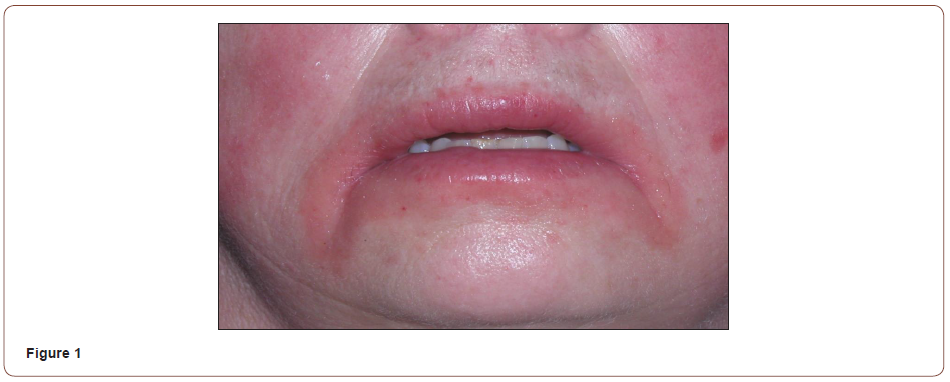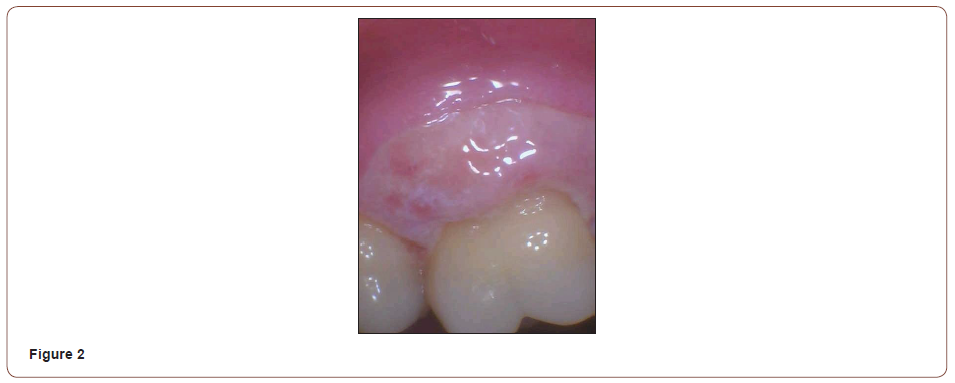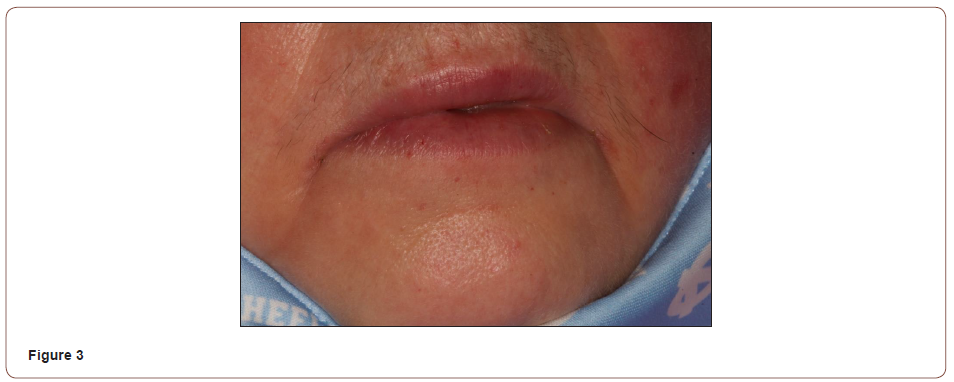Authored by Iquebal Hasan*,
Summary
A 57-year-old female was referred for evaluation of facial rash and painful lesions in the gingiva, lips, and perioral region. Mouth sores and a fungal infection were initially presumed to be the cause, and the patient was treated with magic mouthwash and Nystatin, respectively. Later on, it was ascertained that the lesions were secondary to excessive intake of vitamin B12. (The lesions were later found to be actualizing from an excessive intake of vitamin B12.) This case-report aims to emphasize the importance of carefully analyzing a patient’s intake of all the prescribed medications as well as over the counter (OTC) dietary supplement to determine any drug interactions and/or overdoses.
Introduction
A 57-year-old female was referred for evaluation of facial rash and painful lesions in the gingiva, lips, and perioral region. Mouth sores and a fungal infection were initially presumed to be the cause, and the patient was treated with magic mouthwash and Nystatin, respectively. Later on, it was ascertained that the lesions were secondary to excessive intake of vitamin B12. (The lesions were later found to be actualizing from an excessive intake of vitamin B12.) This case-report aims to emphasize the importance of carefully analyzing a patient’s intake of all the prescribed medications as well as over the counter (OTC) dietary supplement to determine any drug interactions and/or overdoses.
Background
Lesions, whether peri or intra oral, are very common. They can be caused by viruses, fungi, bacterial infections, ill-fitting dental appliances, underlying systemic disorders…etc. [1]. Such lesions, however, may sometimes manifest from drug-drug interactions and/or overdoses. Vitamin B12 is a nutrient that plays an important role in DNA synthesis and keeping the body’s blood and nerve cells healthy [2, 3]. Its deficiency is associated with hematologic, neurologic, psychiatric, gastrointestinal, dermatologic, and cardiovascular manifestations, such as megaloblastic anemia and pancytopenia [2]. On the other hand, excessive intake of (supplementing with excessively high levels of) B12 has been linked to adverse effects impacting different systems of the body (some negative side effects;). We came across a narrative review, case report and few articles which indicated that megadoses of the vitamin can lead to rosacea, skin rash and acne [4-6].
Case Presentation
A 57-year-old female patient was referred by her dentist for evaluation of lesions in the gingiva, on her lips, perioral and facial regions. Additionally, there was some pain (7-8/10) and swelling in the lips, which all started around a month prior. Patient’s extensive medical history included anemia, heart murmur, endometriosis, anxiety disorder, depression, osteoarthritis, rheumatoid arthritis, osteoporosis, coronary heart failure (CHF), hypertension (HTN), attention-deficit hyperactivity disorder (ADHD), gout, neuropathy, diabetes, and B12 deficiency. At the time of consultation, medications included Duloxetine; Bupropion; Furosemide; HCTZ; Dextroam-Amphet ER; Tizanidine; Allopurinol; Trazodone; Pregabalin; Metformin; Olopatadine; Ferrex; Docusate; Aspirin; Beneprotein; MiraLAX. Family history disclosed that mother and sister had rheumatoid arthritis, and father died of myocardial infarction. No significant social history was identified. Patient tried Aquaphor for her lips, but it did not help. PCP prescribed an unknown combination of magic mouthwash, but that did not help her either. Finally, she was prescribed a Nystatin rinse by her dentist, which was also ineffective.
During the initial examination, significant clinical findings were detected including dry eyes, dry skin, dry mouth, dry nose, and a facial rash that patient stated to have had all her life. Furthermore, some swelling and ulcerations of the lower lip were noted (Figure 1). Intraoral examination revealed a white area with petechiae on the left gingiva and there was some cobblestone appearance of the left buccal mucosa (Figure 2). Initial working diagnosis included Systemic Lupus Erythematosus (SLE), Crohn’s disease, hematinic deficiency, xerostomia, and angular cheilitis. Blood work was ordered which included CBC, tests for autoimmune diseases and hematinic deficiencies. Patient was prescribed deficiencies Nystatin and Triamcinolone for her lesions, and OTC xerostomia products.
At the follow-up appointment, patient some noted improvement of perioral lesions and not intraoral lesions. Blood work indicated the possibility of SLE and high levels of vitamin B12. On asking about vitamin B12 dietary supplement, patient initially denied taking it but later stated that she keeps “popping” B12 pills as it “gave her energy” (Figure 1, 2).


Treatment plan
1. Patient was referred to rheumatologist who assessed her and bloodwork and did not think it was SLE and instead suspected Rheumatoid Arthritis or Sjogren’s Syndrome. He sent the patient back for minor salivary gland biopsy. The result for minor salivary gland biopsy was negative with focus score of 0.3. The final diagnosis for autoimmune condition was RA which is very unlikely to cause rashes and erythema’s seen in this patient.
2. The lesions for which the patient was that initially referred to the clinic were diagnosed as angular cheilitis and rosacea from excessive B12 intake. She was advised to stop taking B12.
3. Patient was given a refill for Nystatin and Triamcinolone for management of angular cheilitis. Significant improvement was noted with the combination of recommendations, with pain subsiding and lesions fully-clearing (Figure 3).
4. Patient has been advised to follow up with GI specialist as well.

Discussion
Although patients with Crohn’s disease may experience a deficiency in vitamin B12 (cobalamin), the current literature does not support an association of Crohn’s disease in general, regardless of ileal involvement, with vitamin B12 deficiency [7]. Certain research has shown that only patients with ileal resections greater than 20cm in Crohn’s disease predispose to vitamin B12 deficiency and warrant treatment [7]. Many patients with bowel disorders undergo unnecessary treatment for vitamin B12 without confirmatory tests to guide management [8]. In this case, the patient took it upon herself to treat her deficiency by over-consuming vitamin B12 pills, ultimately contributing to her lesions. Current literature findings and recommendations require verification in further studies using confirmatory biomarkers as per diagnostic guidelines for vitamin B12 deficiency. Serum B12 levels alone are likely inadequate for deficiency diagnosis in asymptomatic patients [7]. We should also make an effort to thinks outside the box. Not all the rashes on face are because of SLE. Intraoral lesions are still suspected to be Crohn’s related. All this indicates a few things which we must keep in mind when evaluating patients with complex conditions in head and neck region or intraorally. Not all over the counter medications are absolutely safe and they should be taken only if needed and recommended by your healthcare provider. Our mouth is a part of our body and what happens elsewhere in the body can impact the mouth and it’s adjacent areas. Dentistry is evolving and it is time for providers to think beyond the traditional concept of dentistry which focused only on teeth [9].
To read more about this article...Open access Journal of Dentistry & Oral Health
Please follow the URL to access more information about this article
https://irispublishers.com/ojdoh/fulltext/are-over-the-counter-supplements-always-safe-a-case-report-summary.ID.000617.php
To know more about our Journals...Iris Publishers
To know about Open Access Publishers





No comments:
Post a Comment